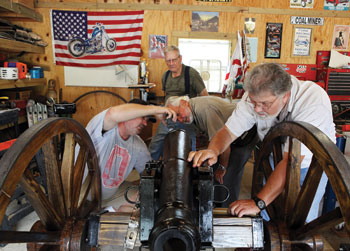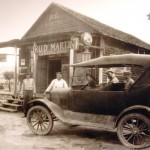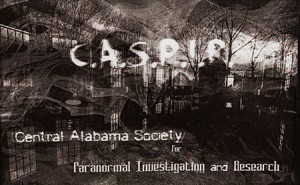
Alabama Artillery recreates historic cannons
Story by Jerry Smith
Photos by Jerry Martin
Stewarts is a historic little community on Mineral Springs Road near Pell City. It’s scenic and pretty quiet, at least most of the time. But just up the road on Bowman Circle, a four-man group called Alabama Artillery occasionally punctuates Stewarts’ tranquility with sounds unheard since the Civil War.
About a year and a half ago, John P. Church approached two of his sons with an idea. “Boys, let’s build a cannon!” Inspired by a smaller project completed by John’s 16-year-old nephew, Jordan Church, they reasoned that between them they had enough technical expertise and manual skills to construct and safely operate a working reproduction of a Civil War field artillery piece.
John, Mike and Doug Church spent weeks assembling materials and information before the actual metal and woodwork began. From their previous involvement in the coal industry in Pike County, Kentucky, plus other interests, the trio sports a collective resume of gunpowder handling, hydraulics, millwork, carpentry, blueprint reading, blacksmithing, steel erection, metal fabricating and federal safety certifications, so this project was virtually assured of success from the start.
John’s mechanical ingenuity was first evidenced in childhood. As one of 11 children born to a coal miner’s family in Buchanan County, Virginia, he built many of their toys, like seesaws, wagons, merry-go-rounds and swings.
 John was in the 17th Airborne Division during the Korean War. Like many other paratrooper volunteers, he jumped out of the first airplane he ever boarded. John went on to Officer Candidate School and at age 19, became the youngest drill sergeant in the Army. He’s also been an ordained Baptist minister for more than 50 years.
John was in the 17th Airborne Division during the Korean War. Like many other paratrooper volunteers, he jumped out of the first airplane he ever boarded. John went on to Officer Candidate School and at age 19, became the youngest drill sergeant in the Army. He’s also been an ordained Baptist minister for more than 50 years.
While work proceeded on Number One, as they named their first cannon, the Churches were joined by a neighbor, Joe Johnson, who became a sort of d’Artagnan to “The Three Cannoneers.” A veteran jet fighter pilot who served in Vietnam and other theaters, Johnson had later worked in airplane propeller repair, so precision machine work and fine wood finishing were well within his purview. Joe also is an active member of the Ashville chapter of Sons of Confederate Veterans. When he came aboard, the now-complete cannon team assumed the sobriquet of Alabama Artillery.
To look at these fellows, one would assume all four are in their late 50s like brothers Doug, 58, and Mike, 61. But Joe is 79, and John, who rides a Harley Davidson Road King when he’s not working on shop projects, is 81. Both men are admirably fit for their age — actually, for any age.
The Alabama Artillery performs cannon firings and static displays for a variety of patriotic and general-interest events. When asked about the team’s mission statement, John replied, “I can tell you in three words: We honor veterans”.
And they mean what they say. The group works entirely at its own expense. While their weaponry and self-chosen uniforms bear a proper resemblance to Confederate Army accoutrements, these men have equally strong feelings of patriotism and pride for American warriors of all battles, from the American Revolution through Afghanistan and Iraq.
Cannon Number One is a freestyle facsimile of a Tredegar Mountain Rifle. Its barrel is about a yard long, has a 2-inch bore and is mounted on a beautifully crafted, large-wheeled gun carriage with matching limber.
A limber is a separate, two-wheeled cart that carries an ammunition chest full of gunpowder, cannonballs, spare parts and other gun supplies and is rigged to tow the cannon for cross-country transport. A truly authentic limber also has provisions to hitch a team of horses, but the Alabama Artillery is more likely to move its piece on a flatbed truck or tow it with a trailer hitch behind a four-wheeler.
Together, the limber and gun make up a complete field artillery unit. Limbers were also used in combat to tow caissons, which are similar two-wheeled carts with additional ammunition chests and, often, a spare wheel or two. A limber/caisson combo becomes essentially a four-wheeled supply wagon, totally flexible in the middle for easy travel over rough terrain. Ammo chests often doubled as seats for gunners when on the move, but in hilly or muddy terrain, they all walked to spare the horses.
The men recently completed a second cannon, called Number Two. Its cast-iron barrel was molded especially for them by Dixie Gun Works of Union City, Tennessee. It’s a 3/4-scale replica of what’s called a six-pounder — that is, its cast iron cannon ball would weigh 6 pounds. This was a common field artillery piece used by both armies during the Civil War and in previous conflicts as well.
All metal and woodwork was crafted in Mike and John Church’s home workshop, using a real blacksmith anvil and a combo metal and wood lathe that dates back to the 1940s. Johnson did the final wood finishing on both carriages in his own shop.
They invented some new methods for building carriage wheels with impressive results. Indeed, there’s evidence of constructive improvisation throughout every phase of both projects. For instance, for “live firing,” they use a 1 7/8-inch-trailer hitch ball instead of a much more expensive cast iron cannonball, and barrel swabs are tipped with fuzzy paint rollers instead of costly inlaid fur.
Both guns are mounted on wheeled carriages fabricated from actual Civil War-era engineering drawings, except they’ve been exquisitely finished in stained wood color rather than Army Drab. They’re real show stoppers in every respect. And yes, there will be a (much larger) Number Three.
Firing a field artillery piece is not a casual operation. Each man on a cannon team has a specific job to be executed in an exact way and sequence. Should any man not perform as directed, the entire operation could suddenly become quite dangerous and most likely would fail completely.
The basic field manual on artillery fire dictates a bewildering syllabus of exact instructions and commands, all set in stone and precisely repeated for each shot. During actual combat, especially in “batteries” of several guns, crewmen used hand signals instead of spoken commands because of the deafening noise.
Every cannoneer knew his own job and several others, which helped to compensate for casualties. Remember, the enemy was shooting at them from places of relative safety while the gun crew was totally exposed and unable to shoot back except with their cannon.
The loading drill was choreographed so that the enemy was never sure who’s carrying a live round. In fact, the man who carried powder and ball to the cannon’s muzzle was expected to shield the load with his own body, lest a stray bullet make it explode and kill the entire crew.
Alabama Artillery uses a four-man firing team, but a real Civil War combat gun crew would have numbered from six men to more than a dozen, depending on the weapon’s size and purpose.
Watching a field artillery piece being fired is an unforgettable experience, even if you’ve seen it before. The gun crew performs a customary setup and loading sequence, in full view of its spell-bound audience
Then, with every man in his assigned position and constantly alert to safety issues, the firing officer jerks a long lanyard attached to a primer cap in the rear end of the cannon. A second or two later, the cannon responds with a powerful burst of man-made thunder that’s guaranteed to get anyone’s undivided attention, even if you’re a half mile down the road.
Its muzzle blast kicks up dirt, grass and leaves in front of the weapon, and creates a huge cloud of fiendishly fragrant blue smoke extending many yards downrange. Those who witness a firing at dusk may also see cone-shaped shafts of orange flame boring a hole right through the center of the smoke cloud, comparable to shock waves often seen in supersonic jet engine exhaust.
Everyone reacts differently to the blast. At a recent home school benefit firing, several children screamed with delight, one lady dropped her video camera, and a black Labrador Retriever ran until he was out of sight.
Observers usually have lots of questions, especially after the first shot, and Alabama Artillery welcomes them all. After all, education, heritage and homage to veterans are what they’re all about.
Some of these questions can be quite funny. For instance, “Where’s the trigger?” or “Can you shoot a deer with it?” It’s great stuff from seriously inquiring minds — and as much fun for the cannoneers as the crowd.
Alabama Artillery does not normally load a projectile when firing at public functions, so there’s practically no danger of mishap as long as the crew does its job as proscribed by basic artillery protocol.
In September, artillery members fired their weapon to open a charity dove shoot near Montevallo, an event sponsored by local Masons to benefit Wounded Warriors. They’ve also provided static displays and firings at various school and veterans’ events.
Alabama Artillery requests that anyone who wishes a demonstration for patriotic, civic or school functions should call Mike Church at 205.405.1007 or Doug Church at 205.338.3373 for further information. The group is especially eager to perform for school children. Doug Church, patriarch of an entire family of teachers, will gladly provide a history lesson during the event.
It’s a real bang-up way to begin any celebration.



















